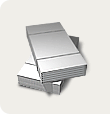There is no need to say much about the meaning of metal alloys. There are a great many of them, and their composition can be very different. Skillful production of quality metals is of great benefit in any technical or handicraft craft, but many factors affect the success of the work done, and a good result is possible only if certain conditions are met.
When making alloys, it is necessary to avoid overheating of metals during their melting. When alloyed, metals have different specific gravity, which is why they must be mixed in the molten state to avoid delamination (or segregation). The surface of metal , when melted, must be coated with fluxing agents such as soda, brown or charcoal.
Before casting the product, it is very desirable to re-melt the alloy made. From a large number of alloy recipes, this article lists only a few that imitate silver or gold, and recipes for casting bearings.
If you need a beautiful golden color or need to replace gold, an alloy of 22 parts gold and 78 parts aluminum is suitable.
For a color absolutely identical to pure gold, it is perfect from 90 parts of copper, 2.5 parts of gold and 7.5 parts of aluminum.
To obtain a hard and resilient alloy from which you can make cutlery (for example, knives for slicing fruit), you need to mix silver and aluminum (5 and 95 parts, respectively).
If you need an alloy that lends itself well to forging, you need to melt 90-95 parts of pure copper and add 5-10 parts of aluminum bronze, metal rolling of such an alloy is not difficult. In order for the alloy to be uniform, it must be remelted and a thick layer of charcoal powder is poured into the crucible. This alloy has a golden yellow color, it resists air and water well, and is perfectly polished. Aluminum bronze can be rolled and wire drawn. If the alloy is heated to a cherry red color, it will be perfectly forgeable. The 1-5% aluminum content allows good soldering with soft solder. If the aluminum content is higher, tin cadmium solder (20 and 15 parts) is used.
For an alloy from which it is easy to cast various products, you need to mix 87 parts of aluminum, 5 parts of tin and 8 parts of copper. The latter may contain from 7 to 8.5 parts, the amount of tin varies from 4.5 to 5.5 parts. This ligature is easy to cast; the molded parts are absolutely uniform and relatively hard. The alloy is easy to process, and the products are beautiful and shiny.
When making small items like brooches or chains, an alloy of 85 parts of copper with 2 parts of zinc and 13 parts of tin is used.
Rolled metal of metals and alloys
|
|
Azovpromstal® 25 May 2012 г. 09:32 |
Subscribe to news 
Metallurgy news
- Today
19:00 Aperam suffers losses amid continued market weakness in Q3 2025 18:00 The value of Taiwan's iron and steel exports decreased by 7.8 percent in January-October 2025 18:00 Federaccai: The green deal and the rules of international trade must be changed 17:00 The German company Salzgitter reports a decrease in net loss for January-September 2025 17:00 Romanian authorities are launching an investigation into possible fraud with the co₂ certificate at Liberty Galati 16:00 EU joins Brazil's initiative to promote global development of carbon markets 16:00 New car Registrations in South Korea Increased by 15.5% in January-October 2025 16:00 Business Philosophy in an Era of change: a lively dialogue between leaders
Publications
09.11 lithium-ion traction batteries from FOMOS EIKTO: an innovative solution for warehouse equipment 06.11 Industrial floors from the company Meridian 03.11 Professional video surveillance for stores 31.10 Professional IT services 30.10 Equire Safe Storage Warehouse





